Winter Holidays and the White House
Foreword: A Season of Traditions by Marcia M. Anderson The Magic of Winter in Washington: A Photographer's Perspective by Bruce...

Main Content
How Long? 9 minutes
Throughout the history of the United States, all the nation’s presidents have been Christians.1 In modern times, to celebrate the holidays, starting in early December the White House is decorated with brightly ornamented Christmas trees, garlands festooned over mantels and doorways, and the eighteenth-century crèche, a gift to the White House collection in 1967, gloriously displayed in the East Room. Choirs and musicians from around the country are invited by the president and first lady to perform Christmas carols during the three and a half weeks of holiday open houses, receptions, and dinners.
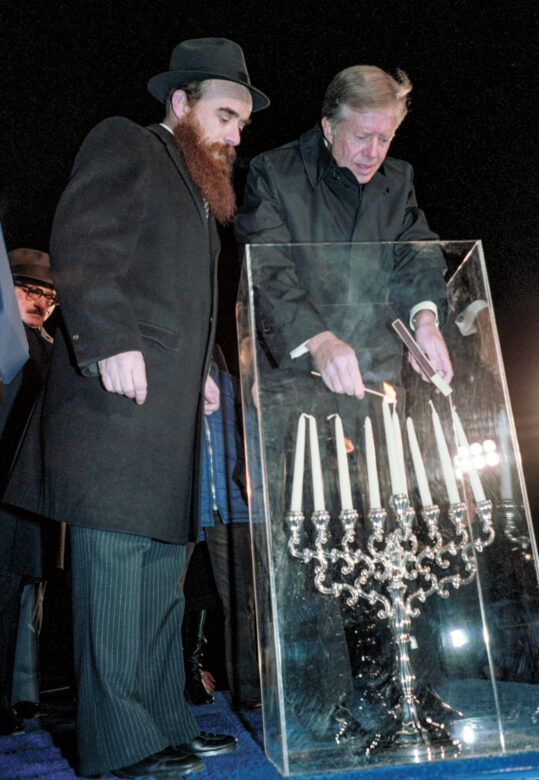
During the 1979 ceremony to light the electrified menorah in Lafayette Park, Jimmy Carter also lit a smaller menorah, which is part of the collection of the Jimmy Carter Presidential Library.
Jimmy Carter Presidential Library
President Ronald Reagan is presented with a menorah by rabbinic representatives of the American Friends of Lubavitch, 1987.
Photo by Dirck Halstead, Life Images Collection Via Getty Images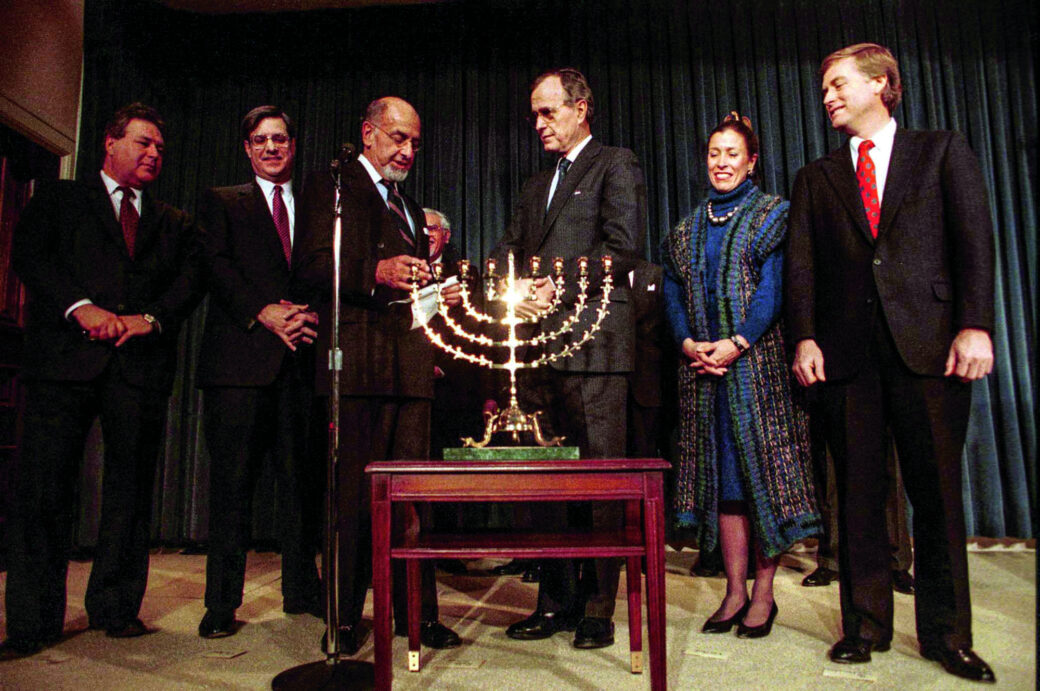
President George H.W. Bush participates in a Hanukkah celebration at the Old Executive Office Building, 1989.
George H.W. Bush Presidential Library
President Bill Clinton looks on as children from the Jewish Primary Day School light a menorah in the Oval Office, 1997.
William J. Clinton Presidential LibraryDecember, as a season of holidays, is also the month of Hanukkah—a celebration of a miracle that happened more than two thousand years ago, when Jews were forbidden to practice their religion. Judah Maccabee and his followers defended their freedom and overcame oppression to reclaim Jerusalem. The oil in the Holy Temple’s menorah that should have lasted one day burned for eight.
In the past forty years, presidents have participated in Hanukkah celebrations to honor the eight-day Festival of Lights and support the local Jewish community. In 1979, President Jimmy Carter walked across Pennsylvania Avenue to Lafayette Park to light one candle in the 30-foot electric menorah displayed there.2 Presidents Ronald Reagan and George H. W. Bush participated in local Hanukkah ceremonies and celebrations. In 1993, a small menorah was lit by President Bill Clinton in the Oval Office and placed on exhibit in the West Wing. This menorah was acquired for the White House Craft Collection and is now in the collection of the William J. Clinton Presidential Library and Museum.3
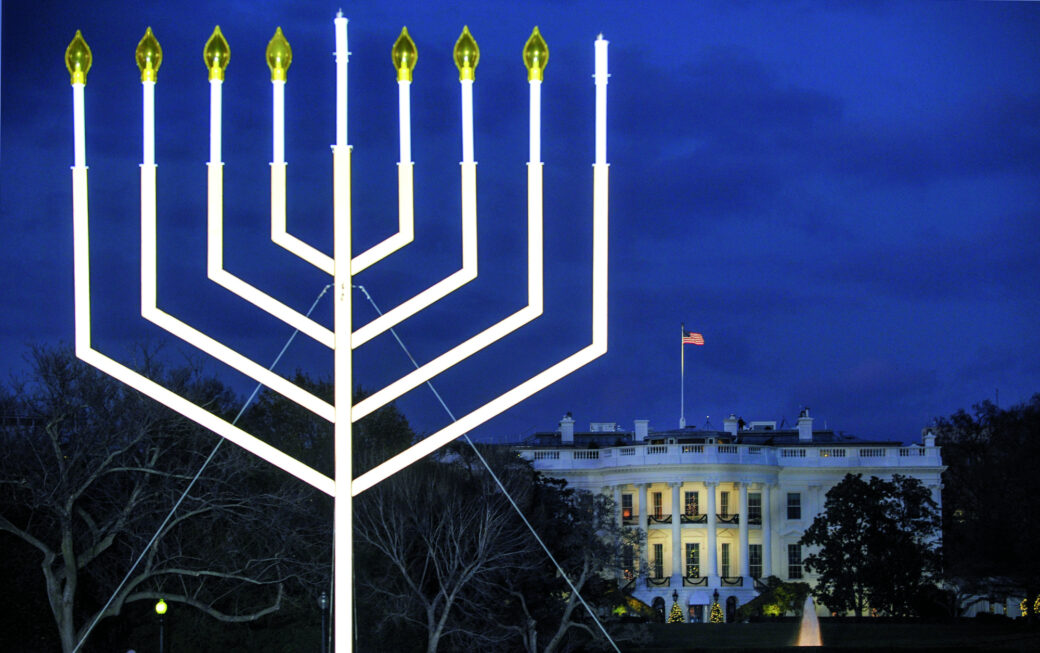
The electrified National Menorah on the Ellipse south of the White House in 2010. The National Menorah was placed in Lafayette Park in 1979 and moved to the Ellipse in 1987.
Getty ImagesSince the George W. Bush administration, the celebration of Hanukkah has been part of the holiday season at the White House, with guests and leaders from the Jewish community across the nation and abroad. A menorah is lit, blessings are made, kosher food is served, and lively Hebrew music is sung and played by choirs and musicians.4 This new tradition began in August 2001, when Jewish Liaison Adam Goldman, appointed by the director of the White House Office of Public Liaison, received a phone call from Andi Ball, chief of staff to First Lady Laura Bush. She explained that holiday entertaining plans were under way and President and Mrs. Bush were interested in adding a Hanukkah celebration event to the December holiday entertaining schedule. He remembered her saying the president and first lady were concerned the Jewish community would feel slighted for having a separate party and asked what Goldman thought. He recalled, “After pulling my jaw off the floor, I explained how proud and honored the community would be.”5
The event started just before dusk on December 10, 2001, with a small group of guests, mostly leaders from the Jewish community, invited for an intimate lighting ceremony of a menorah in the East Garden Room. This was the first lighting ceremony to take place in the Executive Residence.6 A large reception followed, with additional guests invited to join in the celebration. According to Noam Neusner, a friend and colleague of Goldman, “The party had all the features of any Christmas party at the White House, but with a special twist—the Marine band would play chanukkah music favorites most of the evening. One year, a hora—a traditional Jewish circle dance—broke out in the cross hall among party attendees.”7

President George W. Bush and First Lady Laura Bush watch as Talia Lefkowitz lights a candle on the menorah during the first Hanukkah celebration in the Executive Residence in 2001. The menorah was lent to the White House from the Jewish Museum of New York; made in c. 1870 of cast silver, it measures 34 1/2 by 23 3/4 by 14 3/4 inches.
Manny Ceneta, Getty ImagesThe White House does not have a menorah in its permanent collection, so that year, and each year after, the Jewish liaison has worked with scholars and community leaders to identify a menorah with a special significance or historical meaning.8 These might be in U.S. collections, public institutions, and even individual collections in the United States or abroad. Some were used in European Jewish communities before the Holocaust. Once a menorah is identified, the Jewish liaison contacts the Social Office and Office of the Curator to coordinate the loan and have the menorah brought to the White House. Menorahs are considered official museum loans and are treated with the highest standard of care by curatorial staff. The Office of the Curator works with each lender to coordinate museum loan agreement and receipt documentation, insurance coverage, condition reports, photography, packing, transit, and storage logistics. Lenders are responsible for providing information about the menorah as well as handling and assembly instructions.
For the 2001 ceremony, the Jewish Museum in New York lent a Hanukkah lamp from Lvov, Poland (now Ukraine), where a large Jewish population was massacred during World War II. It dates to c. 1870 and is made of cast silver. The Bush administration’s planning committee also carefully considered the religious aspects of the evening, such as who would light this menorah and who would give the blessings. That year, the child of a staff member was selected to light the menorah, as the liaison felt it was a small intimate ceremony. In subsequent years, as the numbers of guests increased, the planning committee often selected someone with a special connection to the menorah or to recent significant events to stand with the president and first lady and light the menorah.9 In 2007, Judea and Ruth Pearl, the parents of the slain Wall Street Journal reporter Daniel Pearl, lit the menorah, which had once belonged to the journalist’s great-grandfather, Chayim Pearl.10

Judea and Ruth Pearl, the parents of murdered Wall Street Journal reporter Daniel Pearl, light their family menorah during the 2007 Hanukkah reception at the White House.
Jim Watson, AFP via Getty ImagesIn 2005, as a gesture of respect and inclusivity to all Jewish affiliations, First Lady Laura Bush directed the White House Main Kitchen to be koshered so that all foods served at the White House Hanukkah reception would be at the highest standard of kosher. This intense process requires a special team of rabbis and assistants to prepare the White House Kitchen and utensils and is completed one to two days before the Hanukkah event.11
In 2008 the Harry S. Truman Presidential Library and Museum lent an eighteenth-century bronze menorah made in Buergel, Germany that had been presented to President Truman by Israeli Prime Minister David Ben-Gurion in 1951 to thank him for his help in establishing the State of Israel in 1948.12 In a touching ceremony held in the Entrance Hall on December 15, 2008, President Truman’s grandson, Clifton Truman Daniel, and Yariv Ben-Eliezer, Ben-Gurion’s grandson, lit the menorah together.

This menorah was made in 1767, and is a bronze menorah from the Synagogue of Buergel in Germany. It is crowned by the double-headed eagle of the old German Imperial Reich.
Harry S. Truman Presidential Library
Prime Minister David Ben-Gurion of Israel presented this bronze menorah to President Harry S. Truman in 1951 in the Oval Office in appreciation for his role in establishing the State of Israel. Abba Eban, Israeli ambassador, is seen on the right.
Harry S. Truman Presidential Library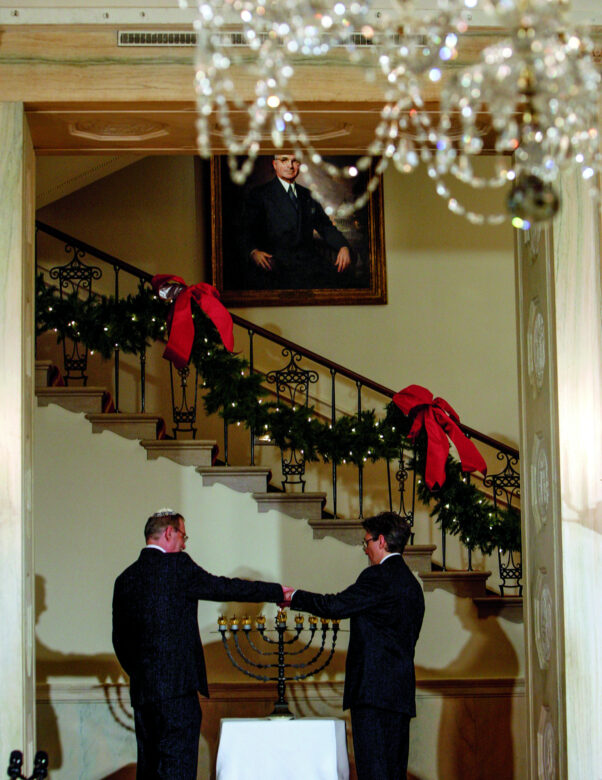
In 2008, the menorah was lent to the White House by the Harry S. Truman Presidential Library and lit by both Clifton Truman Daniel, President Truman's grandson (right), and Yariv Ben-Eliezer, Prime Minister Ben-Gurion's grandson (left), during the annual White House Hanukkah reception.
Photo by Mike Theiler-Pool, Getty ImagesIn 2010, the Barack Obama administration commemorated the devastation of Hurricane Katrina with a stainless steel and brass menorah from the Congregation Beth Israel in Metairie, Louisiana. The menorah was in the synagogue during the flood resulting from the hurricane, and when it was discovered by cleanup crews it was covered in mold, filth, and sewage. A local silversmith restored it, and it was relit for the first time in December 2007. It was one of the few items from the congregation that survived the hurricane.13
In 2013, President and Mrs. Obama started the tradition of hosting two receptions in one day—one in the afternoon and the second in the evening—and borrowing at least two different menorahs, one for each reception and, sometimes, additional ones to display. The National Museum of American Jewish History lent a menorah for the afternoon reception that year. Statue of Liberty Centennial was created by an American immigrant, Manfred Anson, who originally fled Nazi Germany and created a menorah as a tribute to the freedom and opportunity of America and what the Statue of Liberty represented.14 The lamp was lit by Kylie and Lainey Schmitter and their mother, Drew Schmitter. Their father and husband, Jacob Schmitter, was deployed in Afghanistan. U.S. Navy Chaplain Lieutenant Amanda Lurer gave the blessing.15
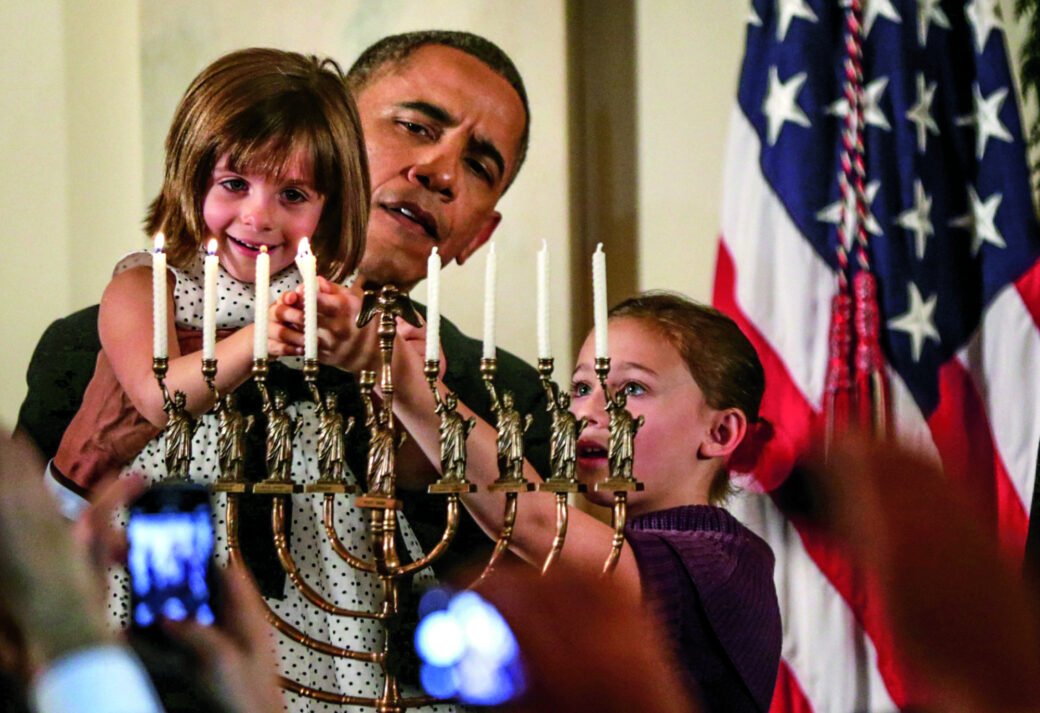
President Barack Obama holds up four-year-old Kylie Schmitter as she and her sister Lainey light a menorah during the first of two 2013 White House Hanukkah receptions. The menorah, which celebrates the Statue of Liberty, was made by Manfred Anson following his escape to America from Nazi Germany.
Getty ImagesFor the 2013 evening reception, the Jewish Museum in Prague lent a cast-brass menorah created in the second half of the nineteenth century. It had been donated to the prayer hall in Hrusov (now known as Ostrava, in the Czech Republic) by Abraham Isaac and his wife, Hayyah Ettinger, in 1922. In 1939, the Nazis expelled the entire Ettinger family from Ostrava and sent them to Poland. Abraham Isaac Ettinger, Hayyah Ettinger, and their children, Else, Edith, and Alfred, were murdered by the Nazis in an unknown place in 1943. The menorah was lit by Holocaust survivors from the former Czechoslovakia, Margit Meissner and Martin Weiss, with blessings given by Rabbi Joshua Sherwin, military chaplain of the U.S. Navy.16

Martin Weiss and Margit Meissner, Holocaust survivors from the former Czechoslovakia, light the Hanukkah menorah as President Barack Obama looks on during the second of two 2013 White House Hanukkah receptions.
ShutterstockIn 2017 President Donald Trump and First Lady Melania Trump hosted one lighting ceremony and reception and invited a few hundred guests instead of the larger guest lists from previous years. The Berman Hebrew Academy Lower School Girls Choir from Rockville, Maryland, performed prior to the lighting ceremony. During this event President Trump declared Jerusalem Israel’s capital and announced that the American Embassy would be relocated there. The United States Holocaust Memorial Museum lent a menorah known to have been used in the Tarnow Ghetto in Poland between March 1941 and September 1943. Made of brass, it was manufactured between 1910 and 1941 and measures 6½ x 7½ x 3½ inches. This menorah was not lit, but displayed during the ceremony as a historic menorah saved during World War II.17
A second menorah on loan from Congregation Shearith Israel of New York City was lit by Arabella and Joseph Kushner, the president’s grandchildren, with their family surrounding them. Oilburning and made of brass, it dates to c. 1730 and is one of the oldest objects in the temple, which has been used continuously by the congregation from colonial days to the present. The menorah was returned to New York the day after the reception so that the congregation could light it for their Hanukkah celebration a few days later.18

Rabbi Meir Yaakov Soloveichik, left, and President Donald Trump's grandchildren, Arabella and Joseph Kushner, light a menorah during the 2017 White House Hanukkah reception. On loan from Congregation Shearith Israel of New York City, the oil-burning brass menorah dates to c. 1730 and measures 14 by 14 by 5 inches.
AlamyIn 2018, the tradition of hosting two Hanukkah receptions and borrowing two menorahs for each lighting ceremony returned. Approximately five hundred guests were invited to each reception, and the tradition of koshering the White House Main Kitchen and serving kosher foods continued.
In 2019, the afternoon reception featured a menorah created by artist, Yaron Bob of Yated, Israel, who uses Kassam rocket metal to sculpt his menorahs.19 The menorah lent for the evening reception was made by Andre Bernard and Ephraim Frenkel, two inmates at the Otisville, New York prison. It was made of copper pies and solder. Rabbi Moshe Margareten, proponent of prison reform and advocate of the 2018 FIRST STEP Act, lit the menorah.20

The silver menorah is ready to be lit as President Donald J. Trump addresses his guests in the East Room at one of two White House Hanukkah receptions in 2018.
AlamyThe Hanukkah lighting ceremonies and receptions at the White House have become an important and meaningful holiday tradition that is proudly anticipated by the Jewish community and its leadership each year, and the important menorahs that have been borrowed for the occasion have added to the significance of this annual event.
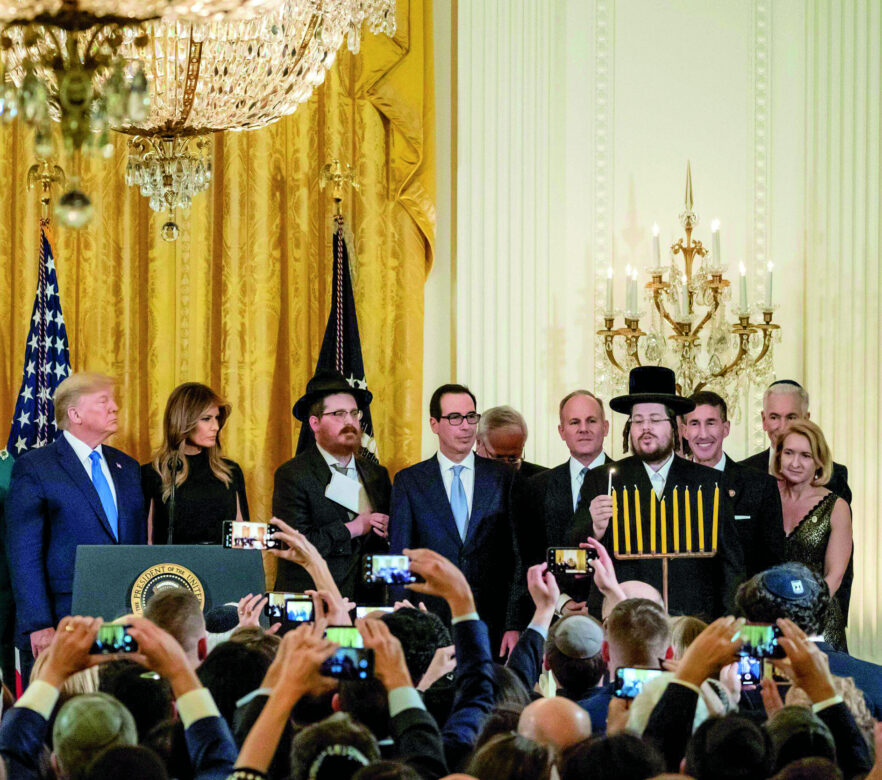
Rabbi Moshe Margareten lights the menorah during a 2019 Hanukkah reception in the East Room. The menorah was made of copper pipes and solder by Andre Bernard and Ephraim Frenkel of Otisville, New York.
Official White House Photo by Shealah CraigheadForeword: A Season of Traditions by Marcia M. Anderson The Magic of Winter in Washington: A Photographer's Perspective by Bruce...
From your family to the First Family, the winter holidays are a special time of year. Stewart McLaurin explores the...
Every year since 1981, the White House Historical Association has had the privilege of designing the Official White House Christmas Ornament....
Every year since 1981, the White House Historical Association has had the privilege of designing the Official White House Christmas Ornament....
On November 22, 1963, about two hours after the assassination of President John F. Kennedy, Vice President Lyndon Baines Johnson took the...
Every year since 1981, the White House Historical Association has had the privilege of designing the Official White House Christmas Ornament....
The White House observance of Christmas before the twentieth century was not an official event. First families decorated the house...
Every year since 1981, the White House Historical Association has had the privilege of designing the Official White House Christmas Ornament....
Thanksgiving is a relatively quiet and personal holiday at the White House, as it precedes a very busy season of...
President Franklin D. Roosevelt was elected to office at the height of the Great Depression. He ushered in an environment...
Since 1878, American presidents and their families have celebrated Easter Monday by hosting an "egg roll" party. Held on the South...
Every year since 1981, the White House Historical Association has had the privilege of designing the Official White House Christmas Ornament....